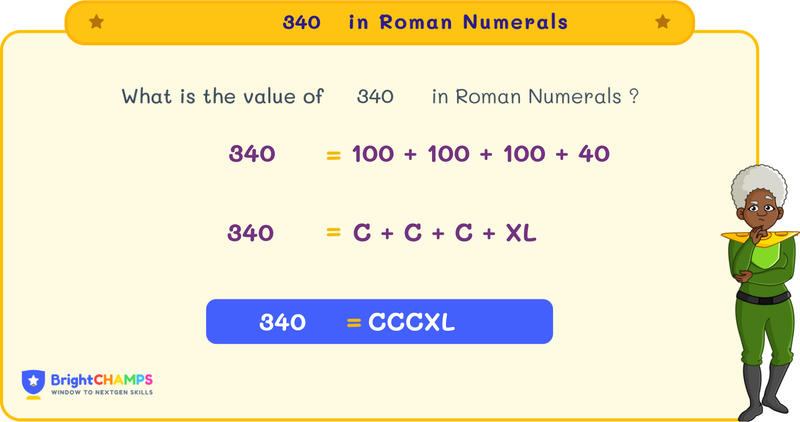


 137 Learners
137 LearnersLast updated on May 26th, 2025

340 in Roman Numerals

Roman numerals are a way of expressing numbers using symbols. The symbols used are I, V, X, L, C, D, and M. Roman Numerals are often used in royal titles, book names, sequences, and more. Here we will discuss Roman Numerals, their rules, and examples.
What is 340 in Roman Numerals?
Royal titles, such as Henry I, Henry II, and so on, use Roman Numerals. Have you noticed these symbols (I, II) and wondered what they represented? Those are the Roman Numerals. In ancient times, people counted using fingers, sticks, bones, etc. As life became more complex, a standard form of counting was required. Ancient Romans used the Roman Numeral system to count. The symbols are I (1), V (5), X (10), L (50), C (100), D (500), and M (1000).
In Roman Numerals, we use CCCXL to represent 340, where C is 100, X is 10, and L is 50. Let's learn more about Roman numerals and how we write them.
Basic Rules for 340 in Roman Numerals
There are certain basic rules for writing numbers in Roman Numerals. Let's discuss some basic rules that need to be remembered when writing numbers in Roman numerals.
Rule 1: Addition Method
The addition method is used when a smaller number is placed after a larger number. For example, VI → V + I → 5 + 1 = 6.
Rule 2: Repetition Method
Certain Roman Numerals can be repeated up to three times to write a larger number. CCC → 300.
Rule 3: Subtraction Method
If a smaller number precedes a larger one in Roman Numerals, you subtract the smaller number from the larger number. For example, IX → X - I → 10 - 1 = 9.
Rule 4: Limitation Rule
Symbols cannot be repeated more than three times, and symbols like V, L, and D cannot be repeated. For example, we write 10 as X and not VV, and 8 is written as VIII, not IIIIIIII.
How to Write 340 in Roman Numerals
Let's now learn how to write 340 in Roman Numerals. Follow these methods to write the number in Roman Numerals.
- By Expansion Method
- By Grouping Method
340 in Roman Numerals by Expansion Method
In the expansion method, based on place value, the number is broken down. In this section, we will learn how to write 340 in Roman numerals using the expansion method.
To write 340 in Roman Numerals, follow these steps:
Step 1: Break the number based on place value into hundreds, tens, and ones.
For 340, we write it as 300 + 40.
Step 2: Convert the number into Roman Numerals:
300 in Roman Numerals — CCC
40 in Roman Numerals — XL
Step 3: Combine the Roman Numerals together:
Therefore, 340 in Roman Numerals is CCC (300) + XL (40) = CCCXL.
340 in Roman Numerals by Grouping Method
When writing a large number into Roman Numerals, we group the number.
To write 340 in Roman Numerals, we group 340 as 300 + 40:
300 in Roman Numerals — CCC
40 in Roman Numerals — XL
So, 340 is written as CCCXL in Roman Numerals.

Common Mistakes and How to Avoid Them in 340 Roman Numerals
Students often make mistakes when writing numbers in Roman Numerals. To master Roman Numerals, we can learn a few common mistakes and ways to avoid them.

340 in Roman Numerals Examples

Problem 1
A historian is cataloging ancient artifacts and finds CCCXL coins from two different eras. If he decides to evenly distribute them into XX collections, how many coins will each collection receive?

Each collection will receive XVII coins.
Explanation
To find out how many coins each collection receives, we divide the total number of coins by the number of collections.
That is CCCXL / XX
CCCXL = 340
XX = 20
Therefore, CCCXL / XX = 340 / 20 = 17.
17 in Roman numerals can be written as XVII.

Problem 2
An archaeologist discovers two ancient scrolls with inscriptions totaling CCC and XL. Determine the combined total of the scrolls in Roman numerals.

The combined total of the scrolls is CCCXL.
Explanation
The sum is the result of adding two numbers.
CCC = 300
XL = 40
300 + 40 = 340
340 in Roman Numerals is CCCXL.
Thus, the sum of CCC and XL is CCCXL.

Problem 3
A librarian needs to subtract the number of missing books, L, from her collection of CCCXC available books. How many books are left in the collection?

The number of books left in the collection is CCCXL.
Explanation
The difference of two numbers is the value we get when subtracting one number from the other.
CCCXC = 390
L = 50
390 - 50 = 340
340 in Roman Numerals can be written as CCCXL.

Problem 4
A museum is organizing an exhibit and wants to display CCXL artifacts alongside an additional C artifacts. Find the total number of artifacts to be displayed.

The total number of artifacts to be displayed is CCCXL.
Explanation
Sum is the result of adding two numbers.
CCXL = 240
C = 100
240 + 100 = 340
340 in Roman Numerals is CCCXL.
The total number of artifacts is CCCXL.

Problem 5
Convert the total of CLXXX and CLX into Roman numerals using the expansion method.

The total of CLXXX and CLX in Roman numerals is CCCXL.
Explanation
Step 1: First convert the numbers 180 and 160 into Roman numerals.
CLXXX = 180
CLX = 160
Add the numbers together: 180 + 160 = 340
Using the expansion method: 340 = 300 + 40 = CCCXL.


FAQs on 340 in Roman Numerals
1.What is 9 in Roman numerals?
2.How to write 340 in Roman numerals?
3.What is 16 in Roman Numerals?
4.Is CCCXL a prime number?
5.What are the multiples of 340?
Important Glossaries for 340 in Roman Numerals
- Addition rule: The addition method is used when a large number is followed by a smaller numeral, and the values are added. For example, CCCXL = CCC + XL = 300 + 40 = 340.
- Grouping method: Here, the given number is grouped based on its place value, and then we convert each group into its Roman numerals. For example, 340 = 300 + 40 = CCCXL.
- Repetition rule: Certain symbols (I, X, C, M) in the Roman numeric system can be repeated only up to three times. For example, CCC = 300 (C is repeated three times to represent the number 300).
- Subtraction rule: The subtraction method is used when a smaller numeral precedes a larger numeral. For example, XL = L - X = 50 - 10 = 40.
- Limitation rule: Roman Numeral symbols such as V, L, and D cannot be repeated, and no symbol can appear more than three times consecutively.
Explore More numbers
 Previous to 340 in Roman Numerals
Previous to 340 in Roman Numerals


Hiralee Lalitkumar Makwana
About the Author
Hiralee Lalitkumar Makwana has almost two years of teaching experience. She is a number ninja as she loves numbers. Her interest in numbers can be seen in the way she cracks math puzzles and hidden patterns.

Fun Fact
: She loves to read number jokes and games.



